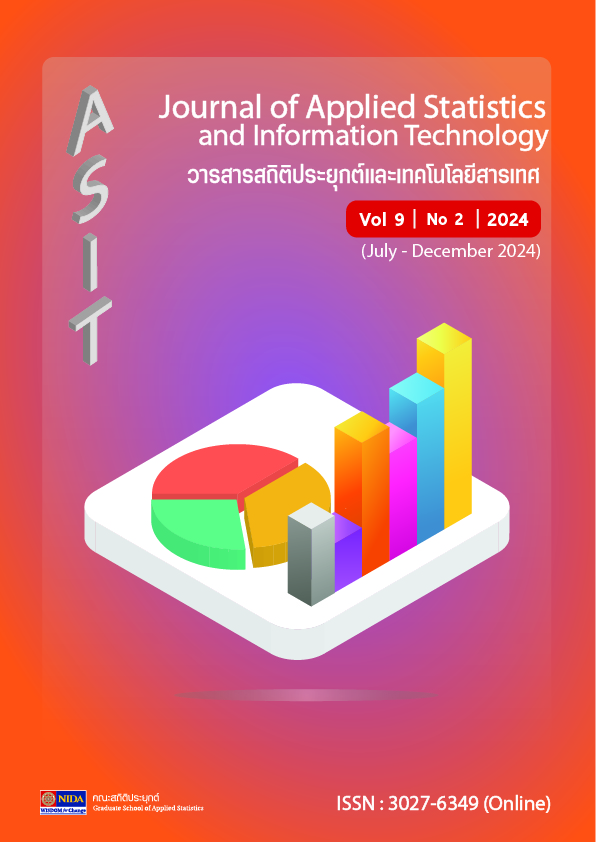Exploring the Use of Real-Time Location Systems (RTLS) to Improve Warehouse Management
Keywords:
Application of RTLS Technology, Warehouse Data Analytics, Congestion Analysis, Warehouse ImprovementAbstract
This research investigates the application of Real-Time Location System (RTLS) technology for enhancing warehouse management efficiency. The study was conducted in two phases. The first is Experimental Design and Data Collection within a Smart Logistics Laboratory: Various scenarios were simulated to assess the impact of RTLS on congestion patterns. The collected data was subsequently analyzed and utilized to improve workflow through simulations incorporating the Traveling Salesman Problem (TSP) Strategy model. The second is Queuing Analysis and Layout Optimization. It proposes to identify Bottlenecks within the warehouse were identified through queuing analysis, and warehouse layouts were redesigned to optimize operational processes. The results of the experiment demonstrate the efficacy of applying RTLS data to significantly improve warehouse management efficiency. For instance, the analysis of RTLS data facilitated the identification of congestion issues, which led to the development of multiple scenario simulations and the implementation of efficient space utilization strategies. Additionally, the acquired data was utilized in simulations to ascertain optimal solutions for enhancing warehouse workflow. A primary limitation of this research was the constraint imposed by limited space. Consequently, future research should consider utilizing actual warehouse spaces and processes to thoroughly evaluate the potential benefits of RTLS implementation.
References
Halawa, F., Dauod, H., Lee, I. G., Li, Y., Yoon, S. W., & Chung, S. H. (2020). Introduction of a real time location system to enhance the warehouse safety and operational efficiency. International Journal of Production Economics, 224, 107541.
https://doi.org/10.1016/j.ijpe.2019.107541
Ketmaneechairat, H., & Soiraya, B. (2565). ระบบติดตามตำแหน่งภายในอาคารแบบเรียลไทม์ระดับเซนติเมตร. The Journal of Industrial Technology, 18(3), 47-68.
Khan, M. G., Huda, N. U., & Zaman, U. K. U. (2022). Smart warehouse management system: Architecture, real-time implementation and prototype design. Machines, 10(2), 150. https://doi.org/10.3390/machines10020150
Lee, I. G., Chung, S. H., & Yoon, S. W. (2020). Two-stage storage assignment to minimize travel time and congestion for warehouse order picking operations. Department of Systems Science and Industrial Engineering, Binghamton University.
Sahara, C. R., & Aamer, A. M. (2022). Real-time data integration of an internet-of-things-based smart warehouse: A case study. International Journal of Pervasive Computing and Communications, 18(5), 622-644. https://doi.org/10.1108/IJPCC-12-2021-0167
Thiede, S., Sullivan, B., Damgrave, R., & Lutters, E. (2021). Real time locating system for human centered production planning and monitoring. Graz University of Technology.
กัญญา ภัคภู่ระย้า. (2559). การจัดการคลังสินค้าของบริษัท ไลอ้อน (ประเทศไทย) จำกัด. Journal of Logistics and Supply Chain Management Ramkhamhaeng, 3(1), 2559.
จินตนา สีหาพงษ์. (2556). RFID เทคโนโลยีอัจฉริยะกับการจัดการคลังสินค้ายุคใหม่. PAYAP UNIVERSITY JOURNAL, 23(2), 47-62.
ชินานันท์ เผ่ากันสีห์ภัค. (2563). แบบจำลองสถานการณ์เพื่อการจัดตารางรถขนส่งที่เหมาะสมสำหรับคลังสินค้าแบบทันเวลาพอดีภายใต้ความไม่แน่นอนด้านเวลาการขนส่ง. วิทยาศาสตรมหาบัณฑิตสาขาวิชาการจัดการโลจิสติกส์ สถาบันบัณฑิตพัฒนบริหารศาสตร์, กรุงเทพฯ.
บงกช เศวตไพศาลกุล. (2563). การปรับปรุงตำแหน่งการวางชิ้นส่วนเครื่องพิมพ์ในคลังสินค้า. วิศวกรรมศาสตร์มหาบัณฑิต, สาขาวิศวกรรมอุตสาหการและการจัดการ มหาวิทยาลัยศิลปากร, นครปฐม.
Downloads
Published
How to Cite
Issue
Section
License
Copyright (c) 2024 Journal of Applied Statistics and Information Technology

This work is licensed under a Creative Commons Attribution-NonCommercial-NoDerivatives 4.0 International License.
เนื้อหาและข้อมูลที่ปรากฏในบทความที่ตีพิมพ์ในวารสารสถิติประยุกต์และเทคโนโลยีสารสนเทศถือเป็นความคิดเห็นส่วนบุคคลของผู้เขียนแต่ละท่าน ความผิดพลาดของข้อความและผลที่อาจเกิดจากนำข้อความเหล่านั้นไปใช้ผู้เขียนบทความจะเป็นผู้รับผิดชอบแต่เพียงผู้เดียว บทความ ข้อมูล เนื้อหา รูปภาพ ฯลฯ ที่ได้รับการตีพิมพ์ในวารสารถือเป็นลิขสิทธิ์ของวารสาร หากบุคคลหรือหน่วยงานใดต้องการนำทั้งหมดหรือส่วนหนึ่งส่วนใดไปเผยแพร่ต่อหรือเพื่อกระทำการใดๆ จะต้องได้รับอนุญาตเป็นลายลักอักษรณ์จากวารสาร ก่อนเท่านั้น



